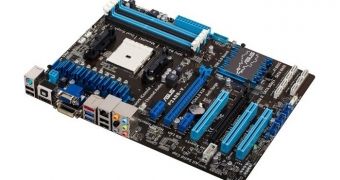The new mainboard that Gigabyte has officially introduced is the sort that will accept any accelerated processing unit (APU) from AMD's Trinity collection, thanks to the A85 chipset.
The FM2 socket has a pin configuration compatible with the latest A-Series APUs. A 6-phase VRM supplies it with the power it needs.
Speaking of power, a 4-pin ATX connector delivers it from the PSU to the mainboard.
For comparison, the F2A85-V Pro, like many other platforms of its ilk, uses an 8-pin EPS (8-phase VRM).
Physically, the motherboard is somewhat peculiar due to its size. It is located somewhere between the ATX and micro-ATX form factors.
That said, four DDR3-1866 memory slots can be found on it. The maximum memory capacity is rated at 64 GB, but that would mean the use of 16 GB DIMMs, which are rare and usually overpriced.
More likely, buyers won't even bother trying to reach that limit. AMD Trinity chips don't really need so much, nor can they actually put it to work.
Moving on, ASUS tossed in a single PCI Express 2.0 x 16 slot (for add-in graphics adapters). The other expansion slots are two PCI Express 2.0 x 1, a PCI Express x16 electrical x4 (wired to the A85X FCH) and three legacy PCI slots.
Furthermore, there are seven SATA 6.0 Gbps ports (for HDDs, SSDs and HHDs), an eSATA 6.0 Gbps connector, four USB 3.0 ports (two back panel, two headers), some USB 2.0/1.1 ports and Gigabit Ethernet.
Finally, ASUS' F2A85-V gets 8-channel HD audio (with optical TOSLINK output), PC/2 peripheral connectivity (mouse/keyboard) and three video outputs (dual-link DVI, D-Sub, and HDMI).
F2A85-V will ship with a price of under $100 / 75-100 Euro, which isn't too bad for a platform driven by the AMI UEFI BIOS and cooled by independent VRM and FCH heatsinks.

 14 DAY TRIAL //
14 DAY TRIAL //